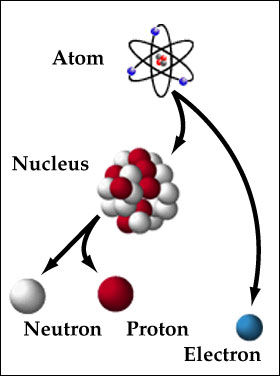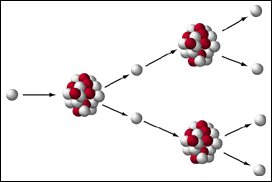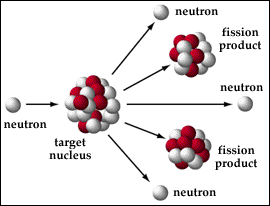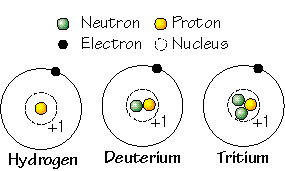| Time Travel Research Center © 2005 Cetin BAL - GSM:+90 05366063183 - Turkey/Denizli |
Introduction to Atomic Physics
An atom is the smallest particle of an element that has the properties characterizing that element. Knowledge about the nature of the atom grew slowly until the early 1900s. One of the first breakthroughs was achieved by Sir Ernest Rutherford in 1911. He established that the mass of the atom is concentrated in its nucleus. He also proposed that the nucleus has a positive charge and is surrounded by negatively charged electrons, which had been discovered in 1897 by J. J. Thomson.
This theory of atomic structure was complemented by Niels Bohr in 1913. The Bohr atom placed the electrons in definite shells, or quantum levels. Understanding the atom continues to be a focus for many scientists.

Components of the atom
Atomic Structure
An atom is a complex arrangement of negatively charged electrons arranged in defined shells about a positively charged nucleus. This nucleus contains most of the atoms mass and is composed of protons and neutrons (except for common hydrogen which has only one proton). All atoms are roughly the same size. A convenient unit of length for measuring atomic sizes is the angstrom (Å), which is defined as 1 x 10-10 meters. The diameter of an atom is approximately 2-3 Å.
In 1897, J. J. Thomson discovered the existence of the electron, marking the beginning of modern atomic physics. The negatively charged electrons follow a random pattern within defined energy shells around the nucleus. Most properties of atoms are based on the number and arrangement of their electrons. The mass of an electron is 9.1 x 10-31 kilograms.
One of the two types of particles found in the nucleus is the proton. The existence of a positively charged particle, a proton, in the nucleus was proved by Sir Ernest Rutherford in 1919. The protons charge is equal but opposite to the negative charge of the electron. The number of protons in the nucleus of an atom determines what kind of chemical element it is. A proton has a mass of 1.67 x 10-27 kilograms.
The neutron is the other type of particle found in the nucleus. It was discovered by a British physicist, Sir James Chadwick. The neutron carries no electrical charge and has the same mass as the proton. With a lack of electrical charge, the neutron is not repelled by the cloud of electrons or by the nucleus, making it a useful tool for probing the structure of the atom.
Even the individual protons and neutrons have internal structure, called quarks. Six types of quarks exist. These subatomic particles cannot be freed and studied in isolation. Current research continues into the structure of the atom.
Atomic Isotopes
Atoms with the same atomic number but with different atomic masses are called isotopes. Isotopes have identical chemical properties, yet have very different nuclear properties. For example, there are three isotopes of hydrogen. Two of these isotopes are stable, (not radioactive), but tritium (one proton and two neutrons) is unstable. Most elements have stable isotopes. Radioactive isotopes can also be created for many elements.

Nuclear Isotopes
Alpha Decay
Alpha decay usually occurs in heavy nuclei such as uranium or plutonium, and therefore is a major part of the radioactive fallout from a nuclear explosion. Since an alpha particle is relatively more massive than other forms of radioactive decay, it can be stopped by a sheet of paper and cannot penetrate human skin. A 4 MeV alpha particle can only travel about 1 inch through the air.
Although the range of an alpha particle is short, if an alpha decaying element is ingested, the alpha particle can do considerable damage to the surrounding tissue. This is why plutonium, with a long half-life, is extremely hazardous if ingested.

Alpha decay
Beta Decay
This form of radioactive decay was discovered by Rutherford in 1899, although the neutrino was not observed until the 1960s. Beta particles have all the characteristics of electrons. At the time of their emission, they travel at nearly the speed of light. A typical .5 MeV particle will travel about 10 feet through the air, and can be stopped by 1-2 inches of wood.

Beta decay
Gamma Rays
Gamma rays are a type of electromagnetic radiation that results from a redistribution of electric charge within a nucleus. Gamma rays are essentially very energetic X rays ; the distinction between the two is not based on their intrinsic nature but rather on their origins. X rays are emitted during atomic processes involving energetic electrons. Gamma radiation is emitted by excited nuclei or other processes involving subatomic particles; it often accompanies alpha or beta radiation, as a nucleus emitting those particles may be left in an excited (higher-energy) state.
Gamma rays are more penetrating than either alpha or beta radiation, but less ionizing. Gamma rays from nuclear fallout would probably cause the largest number of casualties in the event of the use of nuclear weapons in a nuclear war. They produce damage similar to that caused by X-rays such as burns, cancer, and genetic mutations.
Nuclear Chain Reactions
A chain reaction refers to a process in which neutrons released in fission produce an additional fission in at least one further nucleus. This nucleus in turn produces neutrons, and the process repeats. The process may be controlled (nuclear power) or uncontrolled (nuclear weapons).

U235 + n -> fission + 2 or 3 n + 200 MeV
If each neutron releases two more neutrons, then the number of fissions doubles each generation. In that case, in 10 generations there are 1,024 fissions and in 80 generations about 6 x 10 23 (a mole) fissions.
Energy Released From Each Fission
| 165 MeV 7 MeV 6 MeV 7 MeV 6 MeV 9 MeV 200 MeV |
~ kinetic energy of fission products ~ gamma rays ~ kinetic energy of the neutrons ~ energy from fission products ~ gamma rays from fission products ~ anti-neutrinos from fission products |
1 MeV (million electron volts) = 1.609 x 10 -13 joules
Nuclear Fission
When a nucleus fissions, it splits into several smaller fragments. These fragments, or fission products, are about equal to half the original mass. Two or three neutrons are also emitted.

Nuclear Fission
The sum of the masses of these fragments is less than the original mass. This 'missing' mass (about 0.1 percent of the original mass) has been converted into energy according to Einstein's equation.
Fission can occur when a nucleus of a heavy atom captures a neutron, or it can happen spontaneously.
Nuclear Fusion

Nuclear Fission
Nuclear energy can also be released by fusion of two light elements (elements with low atomic numbers). The power that fuels the sun and the stars is nuclear fusion. In a hydrogen bomb, two isotopes of hydrogen, deuterium and tritium are fused to form a nucleus of helium and a neutron. This fusion releases 17.6 MeV of energy. Unlike nuclear fission, there is no limit on the amount of the fusion that can occur.
Radioactive Decay
Radioactivity is the spontaneous disintegration of atomic nuclei. This phenomenon was first reported in 1896 by the French physicist Henri Becquerel. Marie Curie and her husband Pierre contributed further to the understanding of radioactivity. Their research led to the discovery of two new radioactive elements, polonium and radium, and forced scientists to change their ideas about the structure of the atom.
Radioactivity is the result of an atom trying to reach a more stable nuclear configuration. The process of radioactive decay, can be achieved via three methods; a nucleus can change one of its neutrons into a proton with the simultaneous emission of an electron (beta decay), by emitting a helium nucleus (alpha decay), or by spontaneous fission (splitting) into two fragments. Often associated with these events is the release of high energy photons or gamma rays.
Each individual radioactive substance has a characteristic decay period or half-life. A half-life is the interval of time required for one-half of the atomic nuclei of a radioactive sample to decay. The radioactive isotope cobalt 60, which is used in radiation cancer therapy, has, for example, a half-life of 5.26 years. Thus after that interval, a sample originally containing 16 grams of cobalt 60 would contain only 8 grams of cobalt 60 and would emit only half as much radiation. After another interval of 5.26 years, the sample would contain only 4 grams of cobalt 60. Half-lives can range from thousands of years to milliseconds.
Sometimes after undergoing radioactive decay, the new atom is still left in a radioactive form. This means that the atom will decay again as it attempts to reach a stable nuclear state.
Spontaneous Fission

Spontaneous Fission
The spontaneous fission rate is the probability per second that a given atom will fission spontaneously--that is, without any external intervention. If a spontaneous fission occurs before the bomb is fully ready, it could fizzle. Plutonium 239 has a very high spontaneous fission rate compared to the spontaneous fission rate of uranium 235. Scientists had to consider the spontaneous fission rate of each material when designing nuclear weapons.
Einstein's Equation
The mass of the nucleus is about 1 percent smaller than the mass of its individual protons and neutrons. This difference is called the mass defect. The mass defect arises from the energy released when the nucleons (protons and neutrons) bind together to form the nucleus. This energy is called the binding energy. The binding energy determines which nuclei are stable and how much energy is released in a nuclear reaction. Very heavy nuclei and very light nuclei have low binding energies. This implies that a heavy nucleus will release energy when it splits apart (fission), and two light nuclei will release energy when they join (fusion).
The hydrogen 2 nucleus, for example, composed of one proton and one neutron, can be separated completely by supplying 2.23 million electron volts (MeV) of energy. Conversely, when a slowly moving neutron and proton combine to form a hydrogen 2 nucleus, 2.23 MeV are liberated.
The mass defect and binding energy are related by Albert Einsteins formula, E = mc2. In 1905, Einstein developed the special theory of relativity. One of the implications of this theory was that matter and energy are interchangeable with one another. This equation states, a mass (m) can be converted into an amount of energy (E), where c is the speed of light. Because the speed of light is a large number and thus c squared is huge, a small amount of matter can be converted into a tremendous amount of energy. This equation is the key to the power of nuclear weapons and nuclear reactors.
Controlled Nuclear Fission

To maintain a sustained controlled reaction, for every 2 or 3 neutrons released, only one must be allowed to strike another uranium nucleus. If this ratio is less than one then the reaction will die out; if it is greater than one it will grow uncontrolled (an atomic explosion). Nuclear reactions are controlled by a neutron-absorbing material, such as graphite.
The Composition of the Universe
Atomic Structure
Atoms are the basic building blocks of matter (smaller divisions are possible, but for our purposes, the classic structure of atoms will do). Atoms are composites of three particle types:
- electrons
- protons
- neutrons
The electron has a negative charge and orbits around the nucleus, which contains the positively charged protons and neutrons, particles that have no electric charge. Protons and neutrons are much larger and more massive than electrons (and are in fact made up of smaller particles called quarks).

Atoms are mostly empty - a dense nucleus is surrounded by moving electrons. were the proton the size of a grain of sand, the electron shell would be the size of a football field.
Elements, Isotopes, and Molecules
Atoms can have different numbers of electrons, protons, and neutrons. We call atoms that have the same number of electrons and protons elements. The atomic number is defined as the number of protons in the atom.

Atoms of a particular element can have a varying number of neutrons and we identify these variations of the elements isotopes. Some important elements in the study of geology are Carbon-12 and Carbon-13, and Oxygen-16 and Oxygen-18, and Uranium-235 and Uranium-238.

Hiçbir yazı/ resim izinsiz olarak kullanılamaz!! Telif hakları uyarınca bu bir suçtur..! Tüm hakları Çetin BAL' a aittir. Kaynak gösterilmek şartıyla siteden alıntı yapılabilir.
The Time Machine Project © 2005 Cetin BAL - GSM:+90 05366063183 -Turkiye/Denizli
Ana Sayfa /İndex /Roket bilimi / ![]() E-Mail /CetinBAL /Quantum Teleportation-2
E-Mail /CetinBAL /Quantum Teleportation-2
Time Travel Technology /Ziyaretçi Defteri / Duyuru / UFO Technology